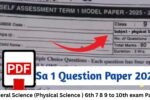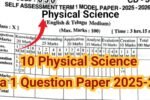GOVERNMENT OF ANDHRA PRADESH
SELF ASSESSMENT TERM – 1 MODEL PAPER 2025 – 2026
Class : VIII Subject : General Science
UDISE Code : __________ PEN ID : __________ Roll No : __________
Time : 3 Hours Maximum Marks : 80
SECTION – A : MULTIPLE CHOICE QUESTIONS
(Each question carries 1 mark – 20 × 1 = 20)
Choose the correct answer from the given options.
- Which of the following is a non-metal?
A) Sodium B) Iron C) Sulphur D) Copper - The process by which plants prepare their own food is called —
A) Respiration B) Photosynthesis C) Transpiration D) Fermentation - SI unit of force is —
A) Joule B) Pascal C) Newton D) Watt - Which of the following is a good conductor of electricity?
A) Plastic B) Rubber C) Copper D) Wood - The device which converts chemical energy into electrical energy —
A) Electric Motor B) Cell C) Generator D) Battery - Which one of the following shows refraction of light?
A) Bouncing of light B) Bending of light C) Scattering of light D) Spreading of light - The gas released during photosynthesis is —
A) Carbon dioxide B) Oxygen C) Nitrogen D) Hydrogen - Which organ controls and coordinates the body?
A) Heart B) Brain C) Kidney D) Liver - The chemical formula of water is —
A) H₂O B) CO₂ C) O₂ D) H₂SO₄ - A change that cannot be reversed is called —
A) Physical change B) Chemical change C) Periodic change D) Temporary change - Heat transfer by direct contact is —
A) Radiation B) Convection C) Conduction D) Reflection - Which of the following is a natural fibre?
A) Nylon B) Polyester C) Cotton D) Rayon - The major component of air is —
A) Carbon dioxide B) Nitrogen C) Oxygen D) Argon - The reflection from a smooth surface is —
A) Irregular reflection B) Diffused reflection C) Regular reflection D) Random reflection - In which state do molecules have the least kinetic energy?
A) Solid B) Liquid C) Gas D) Plasma - In the human body, digestion starts in —
A) Stomach B) Mouth C) Small intestine D) Liver - The motion of a pendulum is an example of —
A) Circular motion B) Periodic motion C) Linear motion D) Random motion - The energy stored in food is —
A) Electrical B) Chemical C) Potential D) Kinetic - Rainwater harvesting helps in —
A) Wasting water B) Soil erosion C) Storing rainwater D) None - Which part of the cell controls all activities?
A) Nucleus B) Cytoplasm C) Cell wall D) Vacuole
SECTION – B : SHORT ANSWER QUESTIONS
(Each question carries 2 marks – 4 × 2 = 8)
- Define force. Write its SI unit.
- Write two differences between physical and chemical changes.
- What are conductors and insulators? Give one example of each.
- What is the role of chlorophyll in photosynthesis?
SECTION – C : APPLICATION / DESCRIPTIVE QUESTIONS
(Each question carries 4 marks – 5 × 4 = 20)
- Explain how light travels in a straight line. Write an activity to show rectilinear propagation of light.
- What is respiration? Explain the process of aerobic respiration in plants.
- State the law of conservation of energy. Give an example to illustrate it.
- Explain the structure and function of the human heart.
- Write the differences between renewable and non-renewable energy sources with two examples each.
SECTION – D : LONG ANSWER QUESTIONS
(Each question carries 8 marks – 4 × 8 = 32)
- Explain the structure of the human digestive system with a neat labelled diagram.
- Describe the water cycle and write the importance of each step in maintaining environmental balance.
- What are acids and bases? Explain their properties and uses with examples.
- Explain the working and applications of an electric circuit containing a bulb, battery and switch.
ANSWER KEY / సమాధానాలు
Section – A : MCQs
1–C 2–B 3–C 4–C 5–B 6–B 7–B 8–B 9–A 10–B
11–C 12–C 13–B 14–C 15–A 16–B 17–B 18–B 19–C 20–A
Section – B : Short Answers
21. Force – a push or pull acting on an object; SI unit: Newton.
22. Physical: reversible (melting ice); Chemical: irreversible (rusting).
23. Conductors allow current (copper); Insulators resist it (plastic).
24. Chlorophyll absorbs sunlight energy for photosynthesis.
Section – C : Application Questions
25. Light travels in straight lines; activity using candle & cardboard holes shows it.
26. Respiration – breakdown of glucose using oxygen → CO₂, H₂O, energy.
27. Energy neither created nor destroyed – pendulum, roller coaster examples.
28. Human heart – 4 chambers (2 atria, 2 ventricles); pumps blood throughout body.
29. Renewable: solar, wind; Non-renewable: coal, petroleum.
Section – D : Long Answers
30. Digestive system – mouth, oesophagus, stomach, small & large intestine; diagram; process of digestion.
31. Water cycle – evaporation, condensation, precipitation, collection; balances nature.
32. Acids (sour, H⁺ donor, e.g., HCl); Bases (bitter, OH⁻ donor, e.g., NaOH); neutralization; daily uses.
33. Electric circuit – current flows from positive to negative through bulb; switch controls; diagram and uses.


